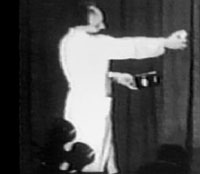|
Schwenk also
collaborated with the leftist youth organization 'Mlada Kultura' in which
the majority of the Jewish intelligentsia was involved. Magazine of the
same name published articles, stories and verse by the left and communists.
In 1939, the organization went underground.
Schwenk was
inexhaustibly inventive, always up to practical jokes and improvisations.
They tell that once in 1939, he was invited to a reception at the Spanish
Embassy in Prague, where he was asked to play the Spanish anthem on the
piano. Sure, he didn't know the melody, but his playing was so high-flown
that all the present were standing at attention for ten minutes.
In Terezin
Schwenk staged a number of plays and revues, the most successful being
Everybody Going… (played 42 times), Ghetto in Itself (38 times), Long Live Life, or Dance Around Skeleton (20 times). Schwenk's performance The Last Bicyclist was forbidden by the Jewish administration. The last
cabaret All Like This But Different was staged in March '44 and played 29 times.
Schwenk becomes
a real 'people's artist'. His songs are sung in the streets of the ghetto,
women and children try to make their own cabarets a la Schwenk. Parody,
joke, improvisation — all this attracted hundreds of people to the attic,
where Schwenk's cabaret was performed. When watching Schwenk's cabaret,
people forgot, albeit for a short moment, the surrounding reality — deaths,
hunger, deportations 'to the East'.
This 'festival
of culture' continued until the fall of 1944… E.M.
|
